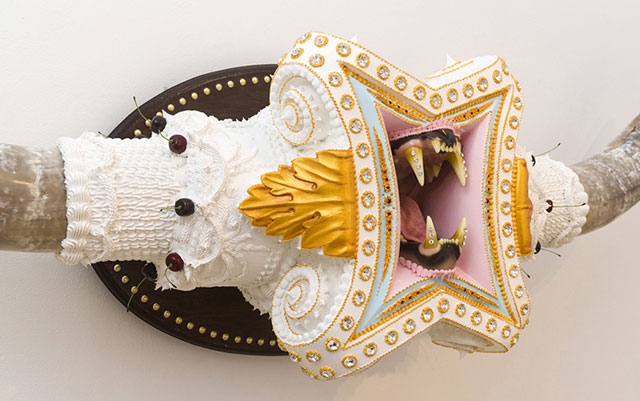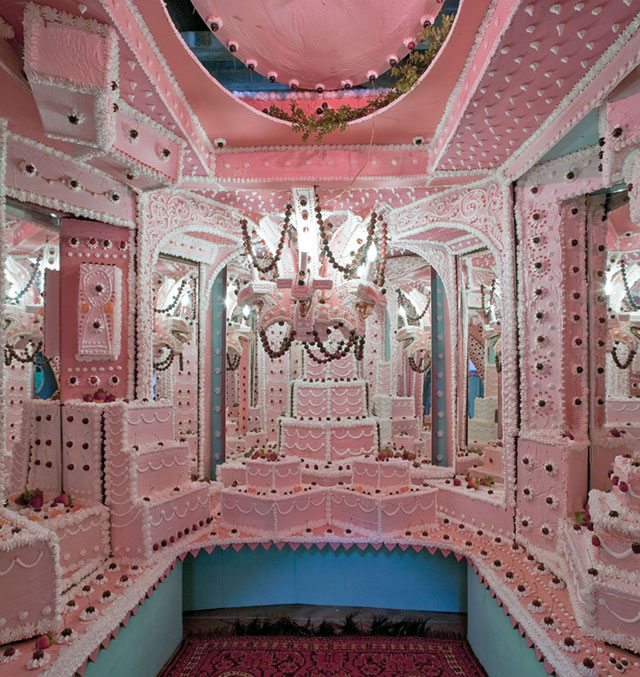How many separate pieces make up the space — or is it one large installation? How long have you been working on it? How long did it take to make?
In the storefront gallery, I have two individual mirror chambers, plus a large mirror maze. There is also a blackened hell pit, which is a favorite aspect for viewers. I have one large wall that features my more conventionally-sized wall hanging sculptures. I have done several versions of Cakeland in the space, and the current configuration has been in place for about a year and a half. I keep working on my installations as long as there is space to keep adding on.
What is the inspiration for your cake-themed work? Where did the idea for adding the teeth come from? (Is it really about the cakes needing to defend themselves?)

I love captivating the emotions of my viewers, and using the image of cake as a language opens people up to be receptive to the messages in the work, whether that message is mine or the viewer’s. The fangs, horns and switchblades are there to add psychological depth to the viewing experience and force the viewer to choose how to integrate the dark elements into the lightness of the cake. This process of integrating dualistic forces is unique to each person, and the art becomes part of them. I strive to make the experience as satisfying as possible.
What are the materials that go into the realistic cake pieces? How long does it take to complete a piece?
I use whatever materials are on hand to create a suitable form, and carve specific elements from a wood-like poly foam. I do the decorative frosting with a variety or acrylic media. A piece can take from three days to three months depending on complexity and scale.
Is there one piece in particular that truly exemplifies your vision? Are you able to describe what makes it successful?
Every piece I work on seems like the breakthrough of the moment. There are a few pieces that have a particular staying power, or an iconic quality that makes them seem newer every day. The womb-like Cake Vault (2008) is a favorite, with its transcendental comfort. Oligarch (2014) has a fierceness that is like a blast of hot wind in the face.
How did the neighborhood take to the space? Did you get a lot of visitors?
Simply by turning some lights on in the storefront improved the semi-sketchy quality of the corner, which I think was appreciated. Making it an interesting viewing experience helped enrich the neighborhood, which is good for everyone. I never have regular hours, which annoys some people… I just wait for the most determined people to track me down and make an appointment.
Why are you moving?
Several reasons. First, the building is in bad need of repair and the owner needs to invest in the space. Second, I’ve run out of space to experiment and I’m not willing to do it in my living room. Third, I’ve really hit a ceiling as far as what I can accomplish here in the Bay Area. I need a bigger space and a more intense playing field. The Bay Area has always been a good place to do art, but not always the best place to leverage one’s art career to its fullest potential.
What plans do you have for the warehouse space in L.A.?
Bigger, better, stronger, faster. I’m going to L.A. to do big things.
Do you think you’ll miss the Bay Area?
Of course! I was born on California Street in the City and raised in the open spaces of Marin. I know and love many secret natural places where I recalibrate and recharge. It’s not like I’m making this move because I’m in love with how L.A. looks… though I’m finding out fast that L.A. people are really friendly and genuine. I hope that I’ll make enough money eventually to return and get a cool house in Mill Valley or someplace close to the mountain.



